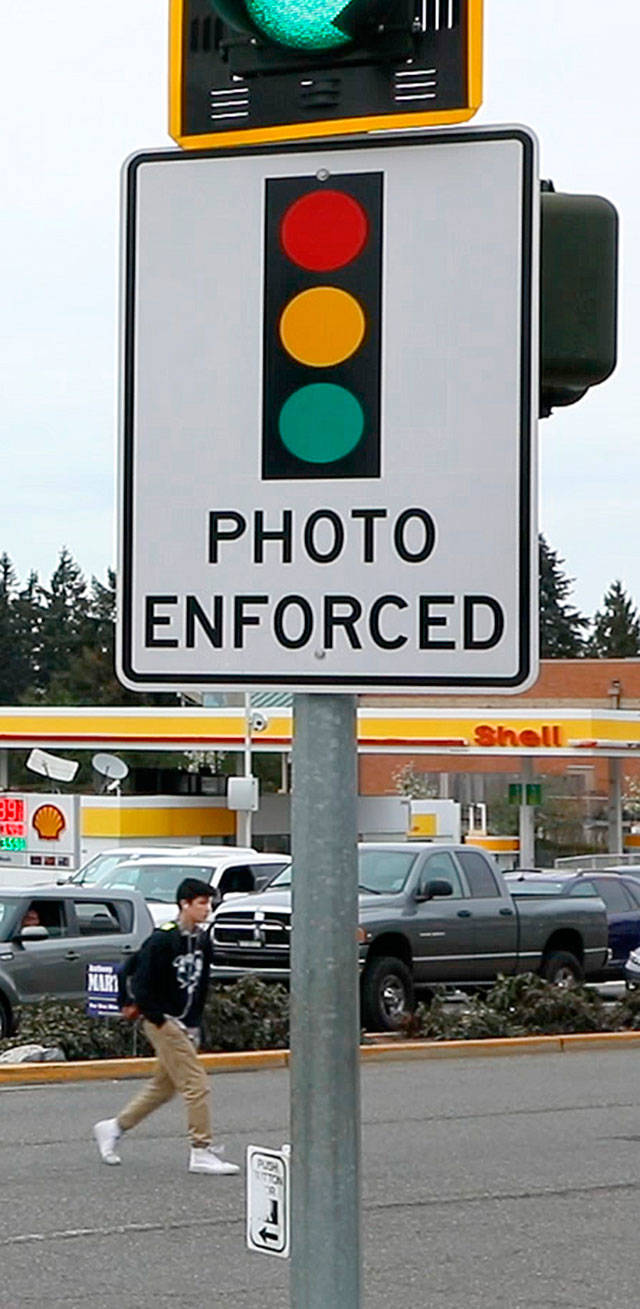A majority of drivers aren’t paying the $136 ticket they receive for running red lights captured by cameras at six Kent intersections.
Kent Police filed 13,587 tickets with Kent Municipal Court in 2019. A total of 5,236 were unpaid and 4,776 were paid, according to court records released in February by the court. Another 3,000 or so remain in transition, i.e. pending payments, hearing requests, court dates, etc., according to an email from Margaret Yetter, court administrator.
The city installed cameras midway through 2019 in an effort to reduce the number of collisions at six intersections and raise revenue to help pay for the police department’s new body-worn cameras.
“We were told to expect a non-payment rate of about 30 percent, so we are looking into why our numbers are higher than anticipated,” Police Chief Rafael Padilla said in a Feb. 28 email.
Drivers – actually registered owners of the vehicle – receive the tickets in the mail after the camera catches the vehicle’s license plate number and officers review the video to decide whether a citation should be issued.
There is no report for why people haven’t paid the tickets, Yetter said. She said 201 tickets were dismissed. The court will forward the unpaid tickets to collections.
Despite the unpaid tickets, the city still brought in about $796,000 in revenue during the five-month period in 2019, according to the City Finance Department. The City Council in November 2018 approved a five-year contract with Arizona-based American Traffic Solutions (ATS) Inc., for as much as $651,000 per year for red-light camera installation and maintenance along with the processing and mailing of infractions.
Kent is using revenue from the red-light cameras to pay for body-worn cameras for 105 police officers at a cost of about $1.63 million over five years or about $320,000 per year.
“Despite the high rate of non-payment, the cameras continue to meet or exceed projections in terms of tickets issued,” Padilla said. “Only time will tell if the systems will continue to pay for themselves and generate revenue.”
If all the tickets had been paid, the revenue would have approached $1.8 million for the five months cameras operated in 2019.
Another early trend shows the number of citations decreasing each month, from a high of 5,280 in August to a low of 2,260 in December.
“We had anticipated that at some point the number of tickets issued would drop off and level out,” Padilla said. “I don’t know that we have had the system running long enough to have a good indication of what this means, and it’s important to remember that there are all kinds of variables that impact the number of violations recorded including weather and technical issues with the system. I believe if we see sustained lower numbers over time, it is a good indication that there are less violations and the cameras are working.”
Padilla said the cameras could even go away.
“One thing we do know for sure is that if drivers obey the law and stop running red lights we will discontinue the deployment of the red-light cameras at those intersections,” he said.
Drivers ran the most red lights while going eastbound on Southeast 240th Street at 104th Avenue Southeast. A total of 1,212 drivers were caught running the red light in August, 823 in September, 542 in October and 483 each in November and December. It had a five-month total of 3,544 citations.
The number of collisions at the six intersections dropped from 149 in 2018 to 127 in 2019. Kent Police picked the six intersections because those streets had the most collisions in previous years.
“I don’t think we have had the cameras operational long enough to make definitive conclusions about their effectiveness,” Padilla said. “That said, for the short period we had the cameras working in 2019, we saw about a 15% decrease in total collisions at the intersections with cameras.”
The intersection of 104th Avenue Southeast and Southeast 240th Street had the most collisions in both years, 35 in 2018 and 34 in 2019. The biggest drop was at Central Avenue North and East Smith Street, which had 23 collisions in 2018 and eight in 2019. Kent Des Moines Road and Pacific Highway South (eastbound only) had a drop from 17 in 2018 to 10 in 2019.
Padilla said, however, the numbers might not tell the whole story.
“I want to be very clear in stating that we have not analyzed the 149 collisions in 2018 versus the 127 in 2019 that occurred at those intersections, so although it appears that the red light cameras are the reason for the decrease in collisions, we haven’t verified that,” he said. “Regardless, the intersections are statistically a little safer than before the cameras and we hope that trend continues.”
Collision stats
(at each intersection)
• 104th Ave SE and SE 240th
2019: 34
2018: 35
• 104th Ave SE and SE 256th St
2019: 25
2018: 25
• 84th Ave S and S 212th St
2019: 29
2018: 24
• Central Ave N and E James St
2019: 21
2018: 25
• Central Ave N and E Smith St
2019: 8
2018: 23
• Kent Des Moines Road and Pac Highway
2019: 10
2018: 17
• Total collisions
2019: 149
2018: 127
Red-light citations
(by month 2019)
July: 1,558 (trial period)
Aug: 5,280 (trial period)
Sept: 4,026
Oct: 3,332
Nov: 2,835
Dec: 2,660
Total: 19,691
Note: About 6,000 citations waived during trial periods
Talk to us
Please share your story tips by emailing editor@kentreporter.com.
To share your opinion for publication, submit a letter through our website https://www.kentreporter.com/submit-letter/. Include your name, address and daytime phone number. (We’ll only publish your name and hometown.) Please keep letters to 300 words or less.

